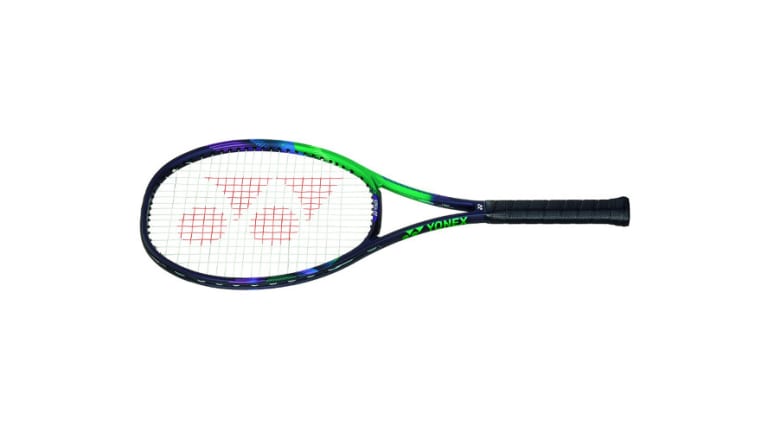SPECS
Price: $249
Head Size: 97 sq. in.
Length: 27 in.
Weight: 12.2 oz.
Balance: 7 pts. HL
Swingweight: 340
RA: 61
Beam Width: 21mm
The heaviest in the line is a lot to handle, but delivers knockout power.
Published Oct 22, 2021

SPECS
Price: $249
Head Size: 97 sq. in.
Length: 27 in.
Weight: 12.2 oz.
Balance: 7 pts. HL
Swingweight: 340
RA: 61
Beam Width: 21mm
So much of a player’s opinion of the new Yonex VCORE PRO 97H will depend on their feelings about its mass. The heaviest of the line is somewhat of an Excalibur or Thor’s Hammer of racquets—it packs a wallop for those worthy of swinging it. The static weight is north of 12 oz.; the swingweight is (checks notes…340?!?!) even more considerable and plays every bit of it. Certain frames do a good job of hiding their beefiness, but the VCP 97H is not shy. Unless currently playing with a previous version or one of the scant few of similar build, most immediate impressions will be that it’s simply too much racquet.
For that reason, it’s a frame that requires simmering. Admittedly, I generally use a racquet that’s close to its dimensions, so it wasn’t a massive adjustment. Still, I started off finding my preparation hampered and defensive situations problematic; even more so than previous models which weren’t feathers either. It took some time to come to terms with what the racquet was capable of, and how capable I was to make use of it.
On groundstrokes this meant making sure my technique centered on lengthy, fluid swings. When the racquet had time to build momentum into contact, it simply mashed the ball. The stability and plow-through were as good as any frame. Topspin drives carried noticeable finishing power and slices produced nasty skids, both with consistent targeting. The results instilled supreme confidence. Conversely, when I attempted a shot with an abbreviated or rushed stroke, disappointment generally ensued.
Players who favor shorter, violent swings—perhaps with a lot of wrist action—to generate pace and spin will undoubtedly find this a deal-breaker. It just didn’t respond to the quick, whippy strokes that work better with lighter, speedier, firmer frames. Even though it takes some muscle to wield the frame, muscling the ball is not a constructive option.
Serving was a good example. There was certainly mph to be had, but it took a concerted effort to make the mass an asset. I had to turn my shoulders fully, get my hitting elbow away from my body to create more width in the stroke, and make sure my arm had the consistency of a wet noodle. When I did that, serves were heavy and full of trouble. If I tensed up to try to “power” the ball with just a swing, it felt a little like I was hitting the ball through water. Again, players who arm the ball will probably find this exercise too taxing and unrewarding.
While I came to an understanding when driving the ball, I wasn’t as proficient on in-between shots. I had trouble gaging the length of swing needed to hit a drop shot, shovel a short ball deep, or roll an angle. If I wasn’t taking full cuts, I wasn’t confident manipulating the shot. I couldn’t just “flick” the ball to a desired location. But the racquet does possess good feel and ball connection, and do think that given time I’d become more comfortable in these situations.
When the racquet had time to build momentum into contact, it simply mashed the ball. The stability and plow-through were as good as any frame.
Although I’m not sure it will ever match the frame’s capacity to absorb and redirect pace. These were the times when a shorter swing proved fruitful. Whether blocking with a chip, or leaning into the shot with a just a shoulder turn-length swing, it was one of the better return-of-serve racquets I’ve tested in quite a while. Most notably, when turning the tables against a big server. All I had to do was the meet the ball out in front and the racquet would hold steady as a rock and return it to sender with interest.
This also translated well at net. It wasn’t a study in nimbleness, but all I had to do was get the strings in front of the ball and racquet did the rest—easy depth and pace from a short punch with reliable directional control. This update is more flexible than its predecessor which also gave it excellent feel and a softer, more comfortable response. But it’s also slightly thicker, so stability was perhaps even sturdier. It wouldn’t be difficult to envision a strong—in every sense of the word—doubles player putting the frame to good use.
But that turnaround power was a bit of a Catch-22: While great at combatting the sheer pace of big-hitters, if I was stretched and the ball beat the racquet to ideal contact, I couldn’t muster enough of a swing to produce a neutralizing return. The moment I was put on my heels, I felt overmatched. The kernel for success was playing on the front foot, wrestling early control of the point with aggressive serve/return +1 tactics. If I were to devote more time with this racquet, I’d spend it putting myself in defensive situations to become more adept at getting out of them. A steady diet of shoulder raises wouldn't hurt, either.
That said, accomplished players who gravitate toward a frame like the VCORE PRO 97H aren’t deterred by the demands of a weighty racquet. Like its predecessors it owns contact, with a predictable response and tons of mass-based power. The updates to the frame have improved the stability, comfort and feel but made it even more of a load to swing. More than ever, the racquet is suited for a very niche audience. But matched with the right user, it can make you play and feel like a legend.